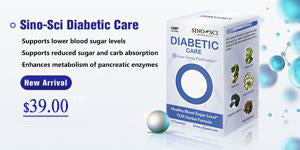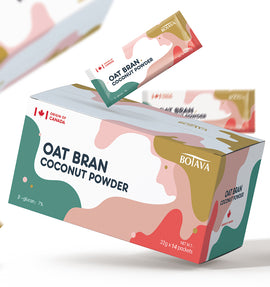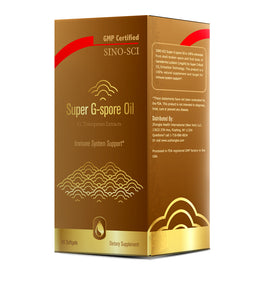
Joint Choice Capsule combines high potency glucosamine, chondroitin, hyaluronic acid and Acerola. We creatively added a Chinese traditional herb extract called Purslane to help nutrient absorption.
- Supports signs of healthy joints: mobility, strength, lubricity, and comfort*

100% Natural Formula.
Sino-Sci Joint Choice can be called 100% natural, no chemical, no addictive so absolutely no side effect. This is the most obvious difference between Sino-Sci Joint Choice and other bone strength products.
- No Chemical
- No Additives
- No Gluten
Ingredients
-

Glucosamine sulfate
Glucosamine is key for the formation of cartilage, the connective tissue that protects the bones in your joints and allows them to slide easily over one another. Studies demonstrate that Glucosamine can support joint mobility. *
-

Deep Sea Chondroitin
Chondroitin is a building block of cartilage that supports joint strength by helping to resist compression in the joint. By helping cartilage retain water, Chondroitin assists or helps in lubricating and cushioning joints. *
-

Hyaluronic Acid
HA has been reported to support joint lubrication and smooth movement. As we get older, our HA tends to decrease. Sino-Sci uses high grade hyaluronic acid.
-

Purslane
The purslane, a traditional Chinese herb, is a great source of two minerals that are important to bone health: calcium and magnesium.
Introduction to Joint
The definition of joints varies a little bit: some define a joint as a point where 2 bones connect. Others suggest it is a point where bones connect for the purpose of moving body parts.
There are three major types of joints:
Synarthroses (immovable). These are fixed or fibrous joints. They’re defined as two or more bones in close contact that have no movement. The bones of the skull are an example. The immovable joints between the plates of the skull are known as sutures.
Amphiarthroses (slightly movable). Also known as cartilaginous joints, these joints are defined as two or more bones held so tightly together that only limited movement can take place. The vertebrae of the spine are good examples.
Diarthroses (freely movable). Also known as synovial joints, these joints have synovial fluid enabling all parts of the joint to smoothly move against each other. These are the most prevalent joints in your body. Examples include joints like the knee and shoulder.
Reference:
Arthritis is the swelling and tenderness of one or more of your joints. The main symptoms of arthritis are joint pain and stiffness, which typically worsen with age. The most common types of arthritis are osteoarthritis and rheumatoid arthritis.
Osteoarthritis causes cartilage — the hard, slippery tissue that covers the ends of bones where they form a joint — to break down. Rheumatoid arthritis is a disease in which the immune system attacks the joints, beginning with the lining of joints.
Uric acid crystals, which form when there's too much uric acid in your blood, can cause gout. Infections or underlying disease, such as psoriasis or SLE, can cause other types of arthritis.
Treatments vary depending on the type of arthritis. The main goals of arthritis treatments are to reduce symptoms and improve quality of life.
Reference:
https://www.mayoclinic.org/diseases-conditions/arthritis/symptoms-causes/syc-20350772
From 2013 to 2015 in the United States
Of people aged 18 to 44 years, 7.1% ever reported doctor-diagnosed arthritis.
Of people aged 45 to 64 years, 29.3% ever reported doctor-diagnosed arthritis.
Of people aged 65 years or older, 49.6% ever reported doctor-diagnosed arthritis.
The risk of arthritis increases with age and arthritis is more common among women than men.
From 2013 to 2015 in the United States, 26% women and 19.1% men ever reported doctor-diagnosed arthritis.
Reference:
https://www.cdc.gov/arthritis/data_statistics/arthritis-related-stats.htm
Occupational therapy:
An occupational therapist (OT) is a specialist who helps people with arthritis, injuries and other conditions maximize their ability to participate in activities safely and enhance their quality of life. The sooner you start working with an occupational therapist, the more you can benefit by making a plan to address your issues.
The plan could include custom-fitting splints or supports that can ease stress on painful joints and help prevent deformity. Occupational therapists also teach people how to protect their joints by performing tasks in different ways than they are used to, such as using both hands or using an assisting device.
People with arthritis really benefit from assisting devices because they help them do more tasks with less pain. Home exercise programs will also help increase their range of motion, flexibility and strength. The goal of occupational therapy is to improve their strength so that they can do certain functional activities, like turning doorknobs, and then continue an exercise plan on their own at home after reaching a certain strength level.
Reference:
You may have already tried other treatments for your arthritis, like over-the-counter pain relievers and corticosteroid injections. If you still have significant symptoms, viscosupplementation might be a good choice to help reduce your pain, stiffness, and swelling. This treatment seems to work best in people with mild or moderate arthritis. It may particularly make sense if you are trying to avoid getting surgery on your joint.
Generally, healthcare providers use viscosupplementation to treat osteoarthritis, but the technique may also benefit people with certain other kinds of arthritis, like rheumatoid arthritis. You can talk to your healthcare provider about whether it is a choice for your type of arthritis.
Hyaluronic acid injection is not always an arthritis treatment choice for all types of joints. The knee is the standard injection site, but you might also be able to get it for arthritis in your hip or possibly in another location.
Reference:
Arthritis is usually a chronic condition and sometimes can lead to disability. However, there are many ways you and your doctor can lessen these problems. One of the ways may be surgery. Joint surgery can offer several benefits, while relief of pain is the most important benefit of joint surgery. Many people with arthritis have constant pain. Some of this pain can be relieved by rest, heat and cold treatments, exercise, splints, and medication. When these therapies don't lessen the pain, surgery should be considered. Improved movement and use of a joint are also important benefits of joint surgery. Continuous inflammation and the wearing away of bone and cartilage can cause joints, tendons, and ligaments to become damaged or pulled out of place. Losing the use of a joint, such as a hip, knee, hand, elbow or shoulder, can seriously hamper a person's activities. When this happens, surgery to replace or stabilize the joint may be suggested. An improvement in the appearance of deformed joints, especially in the hand, can be expected with some types of surgery.
Reference:
Physical therapy (PT) can help you get moving safely and effectively. Physical therapists are licensed professionals with graduate degrees and clinical experience who examine, diagnose and treat or help prevent conditions that limit the body's ability to move and function in daily life, according to the American Physical Therapy Association (APTA).
Physical therapy focuses on the body’s ability to engage in movement. Movement can be anything from getting in and out of chairs to climbing stairs, walking in your neighborhood, playing a sport or doing recreational activities.
The goal of a physical therapy session is to teach you how to do things in your treatment plan – such as performing certain exercises, or how to best use hot and cold compresses – for yourself. The visits are often short – about an hour – and focus on identifying problems with your physical function and giving you strategies for care that you can do at home.
Reference:
Patients with inflammatory arthritis are at greater risk for complications associated with surgery than individuals without the disease. In addition to lowered immunity due to drug therapy, the quality of their bones, and deformities of the joint may contribute to poor outcome. Some problems are diagnosis-specific. Patients with SLE, for example, are particularly vulnerable to avascular necrosis (AVN), a condition in which blood supply to the bone is cut off and the bone dies. This may occur due to the high doses of steroids that are required to control their disease. Patients with ankylosing spondylitis have more difficulty regaining motion due to the stiffness of their tissues from the disease.
Most people don’t have any problems from viscosupplementation, but a small percentage of people do. The most common problem you might encounter is a flare-up of your arthritis just after your injection. This might cause additional pain and swelling in the short term. Healthcare providers are still learning about the best techniques to help reduce the chances of this complication.
Less common risks include bleeding, allergic reaction, pain at the injection site, and infection (you should delay your injection if you have any active infection to help prevent this).
There is also a chance that the treatment will not effectively help your symptoms. Talk to your healthcare provider about all your concerns. Your risks may vary according to your medical conditions and where and how often you get injections.
Treatments include hot packs and deep heat machines, such as ultrasound. Patients can feel good on a painful back, shoulder, or knee. They may help relax you before exercise, but there is no proof that they have any lasting effect.
For example, Studies have found that deep-heat ultrasound, added to an exercise program, does not improve arthritis of the knee. As a consequence, many people are afraid to be physically active when they’re in pain. But avoiding movement only makes the problem worse. This can lead to unnecessary medical procedures, such as knee surgery or steroid injections for back pain.





































